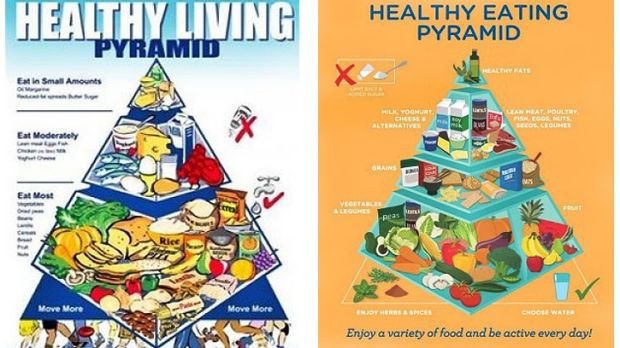
The most recent food pyramid and the new food pyramid.
Finally we have a new food pyramid.
Hip, hip, hooray was the cry of many a nutritional professional on Monday with the release of a new food pyramid after more than 15 years. Traditionally the food pyramid has been used as an educational tool to aid in the understanding of the relative importance of different foods in achieving dietary balance. The issue with this was that for many years breads and cereals filled primary space on our food pyramid.
And as many health professionals started to realise that not only did this not make sense from a calorie and nutrient perspective but as we observed more and more people gaining weight as a result of diets rich in processed carbs, this original education tool became obsolete.

Old news: Pyramids from 1982 and 1986.
Finally, on Monday, thanks to Nutrition Australia, we have a dietary pyramid that we can use. Not only do vegetables hold their rightful place at the bottom of the pyramid with less focus on carbohydrates, but discretionary foods, of which Aussies get more than 30 per cent of their calories from every day, have been completely dropped.
Vegetables have to take centre stage for a number of reasons. Vegetables, with the exception of potatoes, sweet potato and corn, generally contain very few calories. A high intake of vegetables or 10-13 serves per day is closely linked to reduced risk of developing a number of lifestyle diseases, including some types of cancer, heart disease and diabetes. A diet rich in vegetables is also linked to weight control long term. With just 7 per cent of Australians getting their recommended daily serves of vegetables, the focus of the dietary pyramid should always have been on vegetables.
Moving up the pyramid, grains have now replaced the traditional bread and cereal group. Reducing the recommended proportions of carbohydrate-rich foods is an important step in the right direction for nutrition education.

Pyramids over the years.
While wholegrain carbohydrates are nutrient rich, they are also energy dense and with increasingly sedentary lifestyles, many of us need far fewer of them, which is demonstrated in this model. It is also great to see wholegrain carbohydrate options featured predominantly, although some refined examples, such as cous cous, are included to cater for Australia’s multicultural society.
Personally, I would have put legumes such as chickpeas and lentils in the grains category, simply because unlike vegetables they have a significant carbohydrate load. In the new pyramid legumes are included as both a protein (for vegetarians), as well as with the vegetables, thanks to their high fibre content.
Grouping legumes, grains and fruit together as carbohydrates would have allowed the new pyramid to be divided into a vegetable group and then the three main macronutrient groups – carbs, proteins and fats. Dividing foods into these categories, which reflect the way the macronutrients fuel the body in different ways, can make nutrition much easier to explain. When foods are groups according to type, there are inconsistencies, as seen with vegetables, fruits and legumes in which they can cross categories based on their carbohydrate and calorie contents.
The final levels of the new pyramid features dairy and alternatives, meat, nuts and seeds and healthy oils and here Nutrition Australia has got it right. Not only is the emphasis on good quality oil, with margarine and butter getting the boot, but the relative proportions of dairy, meats, nuts and seeds are well demonstrated.
No nutritionist is upset that added processed fats, sugar and “junk” foods previously referred to as “extras” and “eat least” have been eliminated from the pyramid altogether.
Similarly the addition of herbs and spices to season along with plenty of water makes for a very strong Healthy Food Pyramid. Good nutrition is not complicated, it is actually very easy and the take-home message for all of us is just eat more vegetables and you will be on the right track.
Susie Burrell is an accredited practising dietitian
